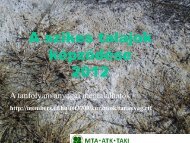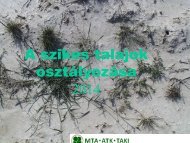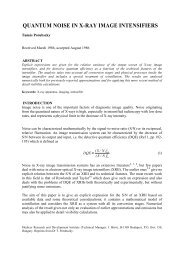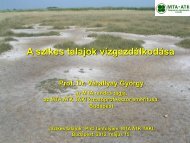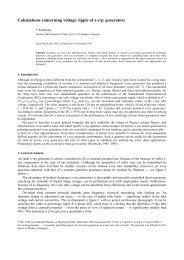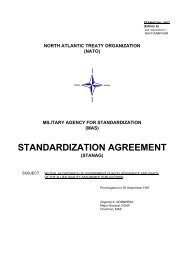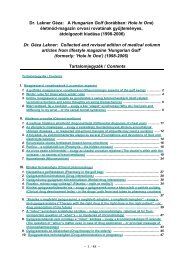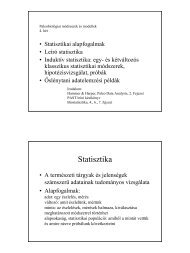Abstract form
Abstract form
Abstract form
You also want an ePaper? Increase the reach of your titles
YUMPU automatically turns print PDFs into web optimized ePapers that Google loves.
Secondary salinization caused by used thermal water seeping<br />
Kitti BALOG*, Andrea FARSANG<br />
University of Szeged, Faculty of Science, Department of Physical Geography and<br />
Geoin<strong>form</strong>atics, Hungary, 6722, Szeged, Egyetem str. 2-6. POB 653<br />
*Corresponding author’s e-mail: kit0822@gmail.com, kit@earth.geo.u-szeged.hu<br />
In our work we present problems connected to thermal water utilization and disposal. In<br />
Hungary thermal water utilization is widespread, because its exploitation is possible on<br />
the 70 % of the area of the country. This hot water of very diverse application can be<br />
used for balneological purpose, drinking water, mineral water, agricultural, industrial or<br />
municipal heating and hot water supply. After usage the thermal water is flowing in<br />
ground channels, and infiltrates into the soil and/or reach the receptive flow, in general<br />
a river. Via a few study cases, e.g. Cserkeszőlő, Tiszakécske, we are going to show<br />
negative effect of this treatment from pedological viewpoint.<br />
In the course of our work we have determined main risk contaminants in sewage<br />
thermal water. Then on different genetic soil types (meadow chernozem and sandy soil)<br />
and various utilization cases (balneological and energetical) we have investigated<br />
effects of used thermal water flowing in channels. The questions are as follows: can<br />
used thermal water leaking cause secondary salt accumulation and salinization, perhaps<br />
any other contaminations in the soil? How can it appear in different genetic soil types?<br />
Can contaminant seep to the groundwater or reach the receptive flow?<br />
Our results show secondary/anthropogenic salt accumulation near to the channels. High<br />
amount of salts is typical of ground water on sandy soil site due to thermal water<br />
leaking into groundwater that enhances the salt content. Hence, salts can transport and<br />
accumulate into the lower soil horizons from which these salts are not able to remove,<br />
because sandy soil does not have capillary lift. It is a site having clay and mould in<br />
Cserkeszőlő where contaminants and salts dissolved in thermal water can adsorb on<br />
colloid surfaces, so can not contaminate ground water. Infiltration is lower, therefore<br />
soil retain both water and dissolved salts. Hereby, salt content of the groundwater has<br />
not increased by thermal water, but in soil we can find salt accumulation level. Two out<br />
of ions originating from thermal water have key role in the evolution of secondary<br />
salinization and accumulation processes: in general Na + , but in some cases Mg 2+ also<br />
accompany the <strong>form</strong>er element and together induce physical soil degradation.<br />
In accordance with the above-mentioned it can be claimed that in the case of used<br />
thermal water seeping we have to pay more attention to the high concentration of<br />
different salts, domination of Na + ions, since they can generate physical and chemical<br />
problems in surrounding soils, reducing productivity of the nearby arable lands.<br />
Key words: thermal water, infiltration, secondary salt accumulation and salinization<br />
3



